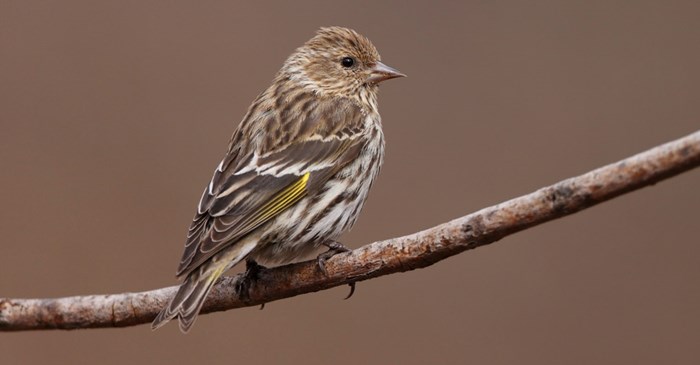Here one year, gone the next. That describes the experience many birders have with the Pine Siskin, a nomadic bird that travels in foraging flocks, migrating to places where they can find ample food supplies to get them through the winter.
If you happen to see them in your yard this fall or winter, break out the Finch or Nyjer feeder and get to know the fundamentals of these lively but hardy little birds.
What does a Pine Siskin look like?
At first glance, the Pine Siskin looks much like a sparrow, with a finely pointed beak and streaky brown feathers covering their small bodies. However, in the wings and tail, you can make out punches of sharp, lemon-yellow lines. Their beaks have the conical shape that confirms their finch identity, equipping them to crush seeds.
What do Pine Siskins eat?
The Pine Siskins get their name from the coniferous trees that provide their food and habitat. They’ll hang upside down from the tips of branches, reaching into cones with their beaks to grab the nutritious seeds inside. They’ll also flock on the ground to eat shoots, weeds and grass seed. One fun thing they do is stand on the stem of a dandelion and gobble up the seed heads. Pine Siskins also include insects and spiders in their diets, sometimes catching them from the air.
Where does the Pine Siskin live?
If you look at a map of their habitat, the short answer is that the Pine Siskin is at home just about everywhere. They live year-round in the western U.S., southern Canada, and central Mexico, and breed throughout northern Canada. But the item of interest here is their migration habits. They are irruptive migrants, meaning they will migrate for the winter to reach better food, but it’s not easy to predict where they’ll end up. So this coming winter, if you find yourself with a lively flock of Pine Siskins in your neighborhood, enjoy them!
How does the Pine Siskin weather the cold winter?
Pine Siskins are quite the hardy winter survivors. Along with bulking up with extra fat and increasing their metabolism on cold winter nights, they can also store up to 10% of their body weight in seeds in a pouch found in their esophagus called the crop. This ready access to food allows them to survive 5-6 nights in subzero temperatures.
Pine Siskins in your backyard
The Pine Siskin favors Nyjer seed as well as hulled sunflowers, but they will also eat seed fragments left behind by stronger-beaked birds. If your area is experiencing an irruption of Pine Siskins, roll out the welcome mat with Lyric Finch Mix.
